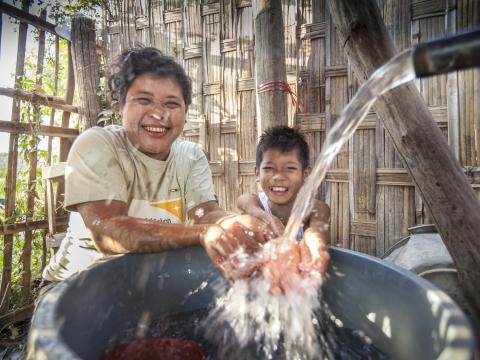Clean water, happy tummy

“Mom usually tells us stories about our childhood before we go to bed. They are always interesting. Our childhood stories include real stories, how we move into this place, how we struggle with sickness. She also tells us general knowledge,” says Hein, 11 year-old studying in grade 6.
Hein is the youngest among three siblings. Hein and his elder brother Ko Ko, now 13 year-old used to get stomach problems when they were small.
“When my children started to get diarrhea, I consulted with my neighbors and treated them with traditional treatment like grinding bitter turmeric or the bark of tamarind tree and mixed with water. But it got worse. They got fever. So, I was panic. Then I took them to the hospital,” recalls Myint, Hein and Ko Ko’s mother.
“It was the flood season but I took my children to the hospital. We had to stay in the hospital for a week. I saw many children die of diarrhea in the village as well as in the hospital. I was so worried for my sons because they got diarrhea one after another,” says Myint.
“I saw my mom was so worried when we got diarrhea and were hospitalized. There was pain inside the stomach. I got fever, sick, and could not eat,” recalls Hein.
Myint and her family lives in a lowland area where water flows in and remains for three to four months during raining season. Once it rains, river water flows in, flooding the area.
The problem starts once water recedes. Dirty water remains in the ponds and wells and contaminated.
“We boiled water for drinking but to wash vegetables and rice to cook, we just used that contaminated water. From there, my children got diarrhea,” Myint comments.
“But I didn’t realized at that time,” she adds.
Clean water is the special need in Hein’s community.
Aware of the community needs, World Vision provided shallow tube wells to get clean water and provided training on personal and environmental hygiene.
“I learned about the importance of using clean water only after I attended trainings,” Myint shares.
Before World Vision provided the tube wells, the community members including Myint’s family relied on the well inside the monastery compound located at a higher ground.
“We had to queue until night to get clean water,” Myint says.
“I used to help my Mom queuing and fetching water. Now we no longer need to queue for water, we just have it close to us,” Hein’s eldest sister, Zin shares.
World Vision not only provided the tube well, but also tested water to see if it is safe to drink. To keep the environmental clean, the agency provided latrines for the households.
“During rainy season when there is flooding, we remove the pump and connect a long pipe until it reaches above water level so that water does not cover the pump and contaminate it,” Myint adds.
World Vision provided 25 water points for 70 HH covering a population of 250 in Hein’s village. Since then, Hein’s mother Myint has also joined World Vision as a volunteer.
“Once I learned about hygiene, I shared it with the mothers in my community; about proper hand washing and personal hygiene, and also to keep their hands clean when preparing food their children,” Myint shares.
“Now we all have enough water to use and drink, no need to worry for water all year round. Even during raining season, we can manage to get clean water by raising the pump level. Our children face no more threats of diarrhea,” Myint smiles.
In the environment free from diarrhea, Hein and Ko Ko are healthy and now studying in school. Their sister Zin is now a caregiver at the World Vision supported early childcare center.
“We have enough water and we are healthy now. We have no more story to tell,” feeling no more struggles about health, Hein and Ko Ko smiles.
